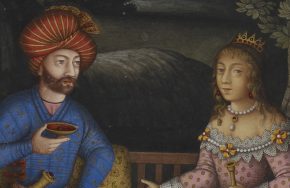Asian Art Museum presents art from three influential Islamic empires

In the cosmopolitan Islamic world of the 16th through 18th centuries, the exciting global exchange of people, ideas and technologies resulted in an atmosphere ripe for innovation. From Feb. 26–May 8, 2016, the Asian Art Museum of San Francisco presents Pearls on a String: Artists, Patrons, and Poets at the Great Islamic Courts , an exhibition telling the personal stories of three creative individuals who flourished within these stimulating societies. Through the written word, painted image and ingeniously engineered object, these men explored new ideas and perspectives — making a lasting impact on the legacies of their empires.
Pearls on a String is one of a trio of special exhibitions kicking off the museum’s 50th anniversary year. The exhibition, says museum director and CEO Jay Xu, embodies the goal that motivated the museum’s creation back in 1966 and still guides it today: to serve as a ‘bridge to understanding’ between East and West.
“The Asian Art Museum showcases art that emphasizes connections across time and place,” Xu says. “ Pearls o n a String does just that, taking us back to a time of tolerance, when Islamic rulers welcomed many religions in their courts, and diverse groups of intellectuals and artisans were encouraged to exchange ideas and work together.”
Through more than 60 exquisite artworks, including an eye-catching bejeweled rifle, the exhibition introduces three fascinating and influential figures: the 16th-century writer Abu’l Fazl in Fatehpur Sikri, the 17th-century painter Muhammad Zaman in Isfahan, and the 18th-century patron Sultan Mahmud I in Istanbul.
Pearls on a String is organized into three vignettes, each delving into the life of one of the individuals and the society in which he lived.
Section 1: The Writer | Abu’l Fazl at the Mughal Court
Entering the exhibition, you’ll first get to know writer and historian Abu’l Fazl ibn Mubarak (1551–1602). Abu’l Fazl witnessed and recorded events both intimate and momentous at the court of Emperor Akbar in 16th-century Mughal India (present-day Pakistan and India). Through Abu’l Fazl’s words, the legacy of this emperor’s influential reign has been preserved for posterity.
From the age of 23 until his death at 51, Abu’l Fazl served the emperor as advisor, chief secretary, ambassador, court historian, translator and trusted friend. His intellectual vigor, humanitarian values and liberal religious sentiments resonated with Akbar, whose court was a multicultural community that engaged with a variety of religious, artistic and intellectual traditions.
Section 2: The Painter | Muhammad Zaman at the Safavid Court
Next, you’ll meet the painter Muhammad Zaman ibn Haji Yusuf (active 1670–1700), who dramatically innovated 17th-century Persian painting at the Safavid court of Shah Sulayman (ruled 1666–94) in Isfahan, Iran.
Zaman is recognized as the pioneer of farangi – sazi (European style), which combined Persian artistic traditions with European iconography and techniques. His hybrid style was used to reinterpret some of the greatest stories of Persian poetry, shining a new light on traditional lore.
As you’ll discover in Pearls on a String , this blending of European and Persian styles of painting was inspired by increasing diversity of the capital of Isfahan. During the 17th century, Western artists, adventurers and merchants poured in, mixing with the existing population primarily comprised of Persian and Central Asian Muslims, Georgians, Armenians, Circassians, Jews and Zoroastrians. The result was a multicultural society that gave Zaman his creative fuel.
Section 3: The Patron | Sultan Mahmud at the Ottoman Court
The final figure you’ll meet is Sultan Mahmud I (ruled 1730–54), who was celebrated in his day both as a sponsor of the arts and as a ruler who brought peace to the Ottoman Empire. Pearls on a St ring explores collaborations between Mahmud, his artisans and merchants, who developed a cosmopolitan court in Istanbul, the empire’s capital, poised at the crossroads of Asia and Europe.
Mahmud — a stout, hunchbacked man without experience in imperial affairs — had many challenges to overcome upon gaining the throne. As a boy in 1703, he witnessed his father’s humiliating removal from office by his uncle Ahmed III (ruled 1703–30). Then in 1730, a revolt broke out against Ahmed, and Mahmud was appointed ruler of a vast and unstable empire. Those who put him on the throne thought they could control him, but Mahmud proved them wrong. He was able to calm public unrest and initiate military reforms.
Using art and architectural patronage, Mahmud underscored his royal lineage and communicated his vision of a technologically advanced empire engaged with Europe. Mahmud was personally involved in commissions and appreciated cleverly engineered objects constructed of rare materials. One of the most remarkable pieces on display in Pearls on a String is a jeweled gun commissioned by Mahmud, which contains a curious assemblage of objects: a gold dagger, a pen case with writing instruments and other accessories, all lavishly encrusted in diamonds, rubies and emeralds.
Through 64 impressive artworks — including manuscripts, paintings, jeweled objects, sculpture, textiles and metalwork — you’ll discover traces of the writer, painter and patron. And you’ll gain a new perspective on how personal relationships can awaken and sustain an artist’s creativity, a process that endures in the present day.
The Asian Art museum San Francisco, until May 8, 2016
Back